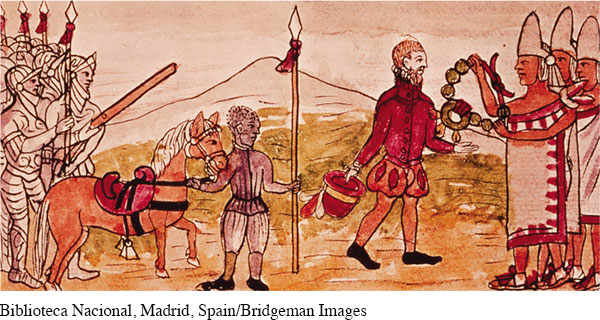Spaniards Conquer Indian Empires
Although rulers in Spain supposedly set the agenda for American ventures, it was difficult to control the campaigns of their emissaries at such a distance. The Spanish crown held the power to grant successful leaders vast amounts of land and Indian labor via the encomienda system. But the leaders themselves then divided up their prizes to reward those who served under them, giving them in effect an authority that they sometimes lacked in law. This dynamic helped make Cortés’s conquest of the Aztecs possible.

Diego de Velásquez, the Spanish governor of Cuba, granted Cortés the right to explore and trade along the coast of South America. He gave him no authority, however, to attack native peoples in the region or claim land for himself. But seeing the possibility for gaining great riches, Cortés forged alliances with local rulers willing to join the attack against the Aztec chief, Montezuma. From the perspective of local Indian communities, Cortés’s presence offered an opportunity to strike back against the brutal Aztec regime.
Despite their assumption of cultural superiority, many Spaniards who accompanied Cortés were astonished by Aztec cities, canals, and temples, which rivaled those in Europe. Seeing these architectural wonders may have given some soldiers pause about trying to conquer the Indian kingdom. But when Montezuma presented Cortés with large quantities of precious objects, including gold-encrusted jewelry, as a peace offering, he alerted Spaniards to the vast wealth awaiting them in the Aztec capital.
When Cortés and his men marched to Tenochtitlán in 1519, Montezuma was indecisive in his response. After an early effort to ambush the Spaniards failed, the Aztec leader allowed Cortés to march his men into the capital city, where they took Montezuma hostage. In response, Aztec warriors attacked the Spaniards, but Cortés and his men managed to fight their way out of Tenochtitlán. They suffered heavy losses and might have been crushed by their Aztec foes but for the alliances forged with native groups in the surrounding area. Given time to regroup, the remaining Spanish soldiers and their allies attacked the Aztecs with superior steel weapons, horses, and trained dogs and gained a final victory.

The Spanish victory was also aided by the germs that soldiers carried with them. Smallpox swept through Tenochtitlán in 1521, killing thousands and leaving Montezuma’s army dramatically weakened. This human catastrophe as much as military resources and strategies allowed Cortés to conquer the capital that year. He then claimed the entire region as New Spain, assigned soldiers to construct the new capital of Mexico City, and asserted Spanish authority over the native groups that had allied with him.
As news of Cortés’s victory spread, other Spanish conquistadors sought gold and glory in the Americas. Most important, in 1524 Francisco Pizarro conquered the vast Inca empire in present-day Peru. Once again, the Spaniards were aided by the spread of European diseases and conflicts among peoples subjected to Inca rule. This victory ensured Spanish access to vast supplies of silver in Potosí (in present-day Bolivia) and the surrounding mountains. Spain was now in control of the most densely populated regions of South America, which also contained the greatest mineral wealth. In one decade, life for Aztecs and other Indians as well as the Spanish changed dramatically. See Document Project 1: Indian and Spanish Encounters in the Americas, 1520–1530.
Exploring American HistoriesPrinted Page 24
Exploring American Histories Value EditionPrinted Page 19
Chapter Timeline